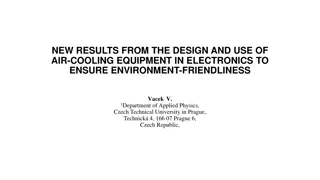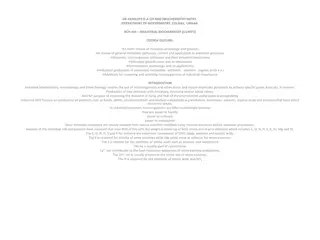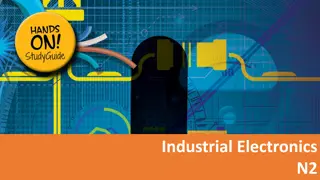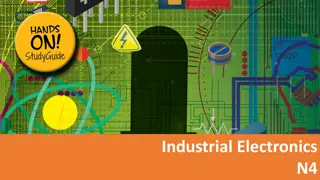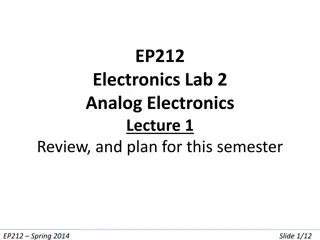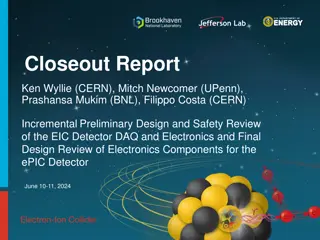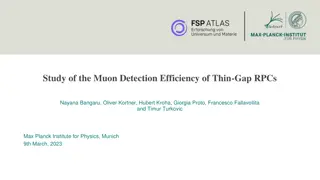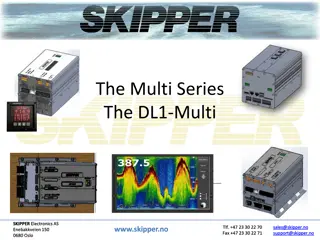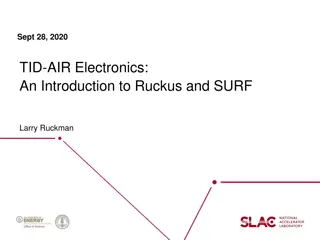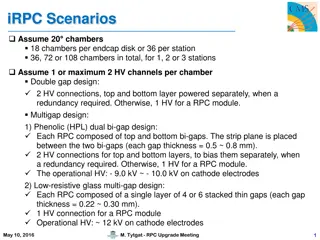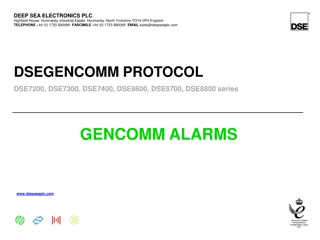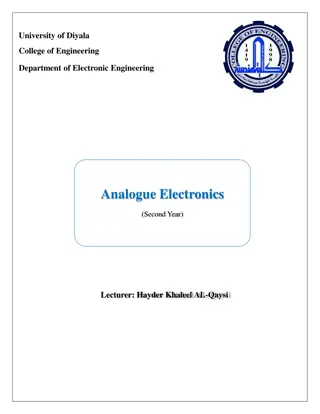Introduction to Industrial Electronics Principles
Uncover the fundamentals of industrial electronics through modules focusing on units of measurement, Greek alphabet, multimeter, basic atomic theory, structure of matter, atoms, and energy shells. Gain insights into key concepts and components essential in the field. Explore the significance of understanding units of measurement, Greek alphabet, atomic theory, and energy shells in electronics applications.
Download Presentation

Please find below an Image/Link to download the presentation.
The content on the website is provided AS IS for your information and personal use only. It may not be sold, licensed, or shared on other websites without obtaining consent from the author.If you encounter any issues during the download, it is possible that the publisher has removed the file from their server.
You are allowed to download the files provided on this website for personal or commercial use, subject to the condition that they are used lawfully. All files are the property of their respective owners.
The content on the website is provided AS IS for your information and personal use only. It may not be sold, licensed, or shared on other websites without obtaining consent from the author.
E N D
Presentation Transcript
Module 1 Introduction to Electronics UNITS OF MEASUREMENT AND PREFIXES It it important to have a solid background and knowledge of the units of measurement in this field of study. This is related to quantities such as: Length. E.g. metres (m) Area. E.g. square metres (?2) Time. E.g. seconds (s) Electromotive forces: Volts (V) Frequency: Hertz (Hz) www.futuremanagers.com
Module 1 Introduction to Electronics (continued) GREEK ALPHABET It is important that you become familiar with the letters of the Greek alphabet in use, such as the following: www.futuremanagers.com
Module 1 Introduction to Electronics (continued) THE MULTI-METER A multi-meter, which can be analogue or digital, has the capability to measure current, voltage and resistance by merely changing to the quantity we would like to measure. www.futuremanagers.com
Module 2 Basic Atomic Theory INTRODUCTION In order to understand the operation of Electronic components and devices it is imperative that we need to have a thorough understanding of basic atomic theory. www.futuremanagers.com
Module 2 Basic Atomic Theory (continued) THE STRUCTURE OF MATTER Matter may be defined as anything that has mass and that occupies space and can be composed of elementary substances that are found in nature. Matter can be divided into the following groups: Solids; Liquids; Gasses; and Plasma. www.futuremanagers.com
Module 2 Basic Atomic Theory (continued) ATOMS An atom may be defined as the smallest part of an element that can participate in a normal chemical reaction. All atoms consist of minute particles of electrical charges arranged in a set pattern and consist of: Electrons; Protons; and Neutrons. www.futuremanagers.com
Module 2 Basic Atomic Theory (continued) ENERGY SHELLS In the diagram, the centre circle represents the nucleus consisting of the protons and neutrons and the outer circle or circles indicates the shells for the orbiting electrons. www.futuremanagers.com
Module 2 Basic Atomic Theory (continued) VALENCY The number of electrons in the outer shell of an atom, called the valence shell, will determine the valency of that element. Valency is an indication of the ability of an atom to gain or lose electrons and will determine the electrical properties of that element. www.futuremanagers.com
Module 2 Basic Atomic Theory (continued) POSITIVE- AND NEGATIVE CHARGES An atom that has valence electrons will always strive to become stable and in doing so will either lose or gain electrons. When an atom gains an electron the atom becomes negatively charged since it has a surplus of electrons and when an atom loses an electron it will become positively charged since it will have a deficit of electrons. www.futuremanagers.com
Module 2 Basic Atomic Theory (continued) CONDUCTION Movement of electrons or conduction can and will take place in any given conducting material, in a desired direction, should a source of power be applied across such material. The conduction process can be by either hole flow (transfer) or electron motion or by both. www.futuremanagers.com
Module 2 Basic Atomic Theory (continued) ENERGY BANDS In any given material, conducting or insulating, there are two distinct energy bands in which electrons may exist, namely the conduction band and the valence band but they will be separated by the forbidden gap. www.futuremanagers.com
Module 3 Conductors and Insulators CONDUCTING MATERIALS All conducting materials are normally metallic and/or alloys of metals and are classified according to the conductivity of that particular material. Silver, for example, is the best conductor but is very expensive. Copper is used more often as it is versatile and affordable. www.futuremanagers.com
Module 3 Conductors and Insulators (continued) ALLOYS There are materials that may be combined chemically so as to give specific properties and this combination is termed an alloy. Examples of alloys include: Brass; Bronze; Soft solder; and Carbon. www.futuremanagers.com
Module 3 Conductors and Insulators (continued) INSULATING MATERIALS An insulator may be defined as an element that will not allow an electrical current to flow since there are no free electrons in those elements. Materials commonly used in the electrical industry include: Pure rubber; Cotton; Paper; and Mica. www.futuremanagers.com
Module 3 Conductors and Insulators (continued) CLASSFICATION OF INSULATING MATERIALS All insulating materials used in electrical engineering and industries today are classified according to the temperature they can withstand. www.futuremanagers.com
Module 4 Resistors INTRODUCTION All conducting materials will have an opposition to the flow of an electrical current and that this phenomenon is termed resistance of that specific material. A resistor is an electronic component, which offers opposition to the flow of an electric current. www.futuremanagers.com
Module 4 Resistors (continued) DETERMINING RESISTANCE Resistance can be determined by means of Colour coding in which selected colours are assigned with a specific numerical value and by merely looking at the colour code and the value of that particular resistor is determined, and Measurement in which an instrument is used to measure the quantities of current, voltage and resistance by selecting the suitable quantity and scale of the variable to be measured. www.futuremanagers.com
Module 4 Resistors (continued) TYPES OF RESISTORS Resistors are divided into two main categories namely: Fixed-types; and Variable- or adjustable types. www.futuremanagers.com
Module 4 Resistors (continued) FACTORS INFLUENCING RESISTANCE The resistance of all materials are dependant upon the following four factors: The resistivity of the material; The length of the material; The cross-sectional area of the conductor; and The temperature. www.futuremanagers.com
Module 4 Resistors (continued) ARRANGEMENT OF RESISTORS Resistors may be arranged in any way so as to give any desired result as we require it to give. They can be arranged in: Series, and Parallel www.futuremanagers.com
Module 5 Capacitors INTRODUCTION Capacitors are extensively used in electronic circuits for coupling, filter networks, tuned circuits and by-passing circuits. A capacitor is a component that will be able to store an electrostatic charge and its unit of measurement is the Farad. www.futuremanagers.com
Module 5 Capacitors (continued) FACTORS THAT INFLUENCE CAPACITANCE There are three main factors that influence the capacity of a capacitor: Dielectric constant; Cross-sectional area of plates; and Distance between the plates. www.futuremanagers.com
Module 5 Capacitors (continued) TYPES OF CAPACITORS There are several types of capacitors such as: Air capacitors; Mica capacitors; Paper capacitors; Ceramic capacitors; Aluminium electrolytic capacitors; and Tantalum electrolytic capacitors. www.futuremanagers.com
Module 5 Capacitors (continued) TESTING OF CAPACITORS When testing capacitors, they be removed from the circuit and discharged and only then can the testing commence. There are two types of faults that can occur in a capacitor and each one will be treated individually: A short-circuited capacitor; and A leaky capacitor. www.futuremanagers.com
Module 5 Capacitors (continued) CHARGING AND DISCHARGING OF A CAPACITOR It takes a period of time for a capacitor to charge up to the supply potential. This period of time is termed the time constant of the capacitor. This time will never exceed five time constants and it mathematically given by: ? = ? ? Where ? = time, R = value of resistance, and C = value of capacitor. www.futuremanagers.com
Module 5 Capacitors (continued) COLOUR CODING OF CAPACITORS This International colour coding concept for capacitors can be illustrated: www.futuremanagers.com
Module 5 Capacitors (continued) ARRANGEMENT OF CAPACITORS Capacitors can be arranged in: Series, and Parallel www.futuremanagers.com
Module 5 Capacitors (continued) REACTANCE OF A CAPACITOR The capacitive reactance is the opposition that will be offered by a capacitor to an alternating quantity. This capacitive can be calculated: 1 ??= 2 ? ? ? Where ?? = Capacitive reactance, f = frequency, and C = the value of capacitor. www.futuremanagers.com
Module 6 Inductors FACTORS INFLUENCING INDUCTANCE An inductor is so manufactured that it will produce a specific amount of inductance and is dependant upon the following factors: The number of turns in the inductor; The cross-sectional area of the core; The permeability, ability to conduct magnetic flux, of the core material; and The length of the inductor. www.futuremanagers.com
Module 6 Inductors (continued) PERMEABILITY The permeability of any material is derived from the fact that the electrons orbiting an atom aids the magnetic flux set up by the current flowing in the inductor. www.futuremanagers.com
Module 6 Inductors (continued) RELATIVE PERMEABILITY Relative permeability indicates the ease with which core atoms line up with a magnetic field. This is mathematically defined as: ? ?? ??= Where ?? = relative permeability, ? = permeability of a specific material, and ?? = relative permeability of a vacuum. www.futuremanagers.com
Module 6 Inductors (continued) TESTING OF INDUCTORS The testing of inductors can also be accomplished using a multi-meter. It is important that the inductor be removed from the circuit before testing commences. www.futuremanagers.com
Module 6 Inductors (continued) INDUCTOR ARRANGEMENTS Inductors can be arranged in: Series Parallel www.futuremanagers.com
Module 6 Inductors (continued) REACTANCE OF AN INDUCTOR The inductive reactance is the opposition that will be offered by an inductor to an alternating quantity. This inductive reactance can be calculated: ??= 2 ? ? ? Where ?? = Inductive reactance, f = frequency of alternating supply, and L = value of inductor. www.futuremanagers.com
Module 7 Magnetism INTRODUCTION Magnetism can be defined as an effect naturally created by certain magnetic materials. www.futuremanagers.com
Module 7 Magnetism (continued) NATURAL MAGNETS The North-pole of the magnet will always be attracted by the North-pole of the earth. A similar action will take place for materials which are attracted by a magnet. Between these poles, lines of magnetic flux will exist which will exert a magnetic force. www.futuremanagers.com
Module 7 Magnetism (continued) LAW OF MAGNETISM The poles of a magnet have a definite relationship towards one another - unlike poles will always attract one another no matter what shape or size. www.futuremanagers.com
Module 7 Magnetism (continued) CURRENT AND MAGNETISM Conductors will follow the same rules as permanent magnets in that attraction and/or repulsion of these magnetic fields can take place. www.futuremanagers.com
Module 7 Magnetism (continued) ELECTROMAGNETS The strength of the magnetism produced by a coil through which an electric current is flowing is dependant upon the following factors: The number of turns in the coil; The magnitude of the current flowing through the coil; The type of core material; and The ratio of the coil diameter to its length. www.futuremanagers.com
Module 7 Magnetism (continued) MAGNETIC INDUCTION It is possible to manufacture a magnet. This is done by using materials with magnetic qualities. If one takes an un-magnetised object into close proximity of a permanent magnet, the molecules will be aligned in the same fashion as that of the magnet creating a North- and South-pole on the same ends as that of the permanent magnet. www.futuremanagers.com
Module 7 Magnetism (continued) ELECTROMAGNETIC INDUCTION Should a permanent magnet be brought in close proximity of a length of wire or passed through a coil, the magnetic flux produced by the magnet will cut across the wire and induce a voltage into the wire, which will cause a current to flow in the wire. www.futuremanagers.com
Module 8 Direct Current Theory CURRENT FLOW There is: Conventional current flow; and Electron current flow. www.futuremanagers.com
Module 8 Direct Current Theory (continued) OHM S LAW The current flowing in a network is directly proportional to the applied voltage and inversely proportional to the resistance of that network. www.futuremanagers.com
Module 8 Direct Current Theory (continued) APPLICATION OF OHM S LAW ? =? ? Where I = current flowing, V = Applied voltage, and R = Resistance. www.futuremanagers.com
Module 8 Direct Current Theory (continued) JOULE S LAW The heat produced by the current and is directly proportional to the square of the current, the resistance and the time. ? = ?2 ? ? Where Q = amount of heat generated, I = current magnitude, R = resistance of element, and t = time duration of current-flow. www.futuremanagers.com
Module 9 Sources of Electricity (Direct Current) INTRODUCTION Electricity may be produced by: Chemical reaction - cells or batteries; Magnetism - generators; Friction - static electricity; Pressure - crystals; Light - photo-conductive devices; and Heat - thermocouples. www.futuremanagers.com
Module 9 Sources of Electricity (Direct Current) (continued) PRIMARY CELLS A primary cell may be described as a device that will generate an electrical potential which will then be capable of delivering an electric current for as long as the chemicals used in the process are active. www.futuremanagers.com
Module 9 Sources of Electricity (Direct Current) (continued) THE LECLANCH WET CELL This cell is not suited for application of a steady current over long periods of time but is best suited for the application of intermittent current at different intervals. Typical values for this type of cell are 1, 5 volt. www.futuremanagers.com
Module 9 Sources of Electricity (Direct Current) (continued) THE LECLANCH DRY CELL These cells can deliver an emf of about 1, 5 volt. Primary cells suffer from a phenomenon termed polarisation and this leads to the rapid reduction of emf. www.futuremanagers.com


